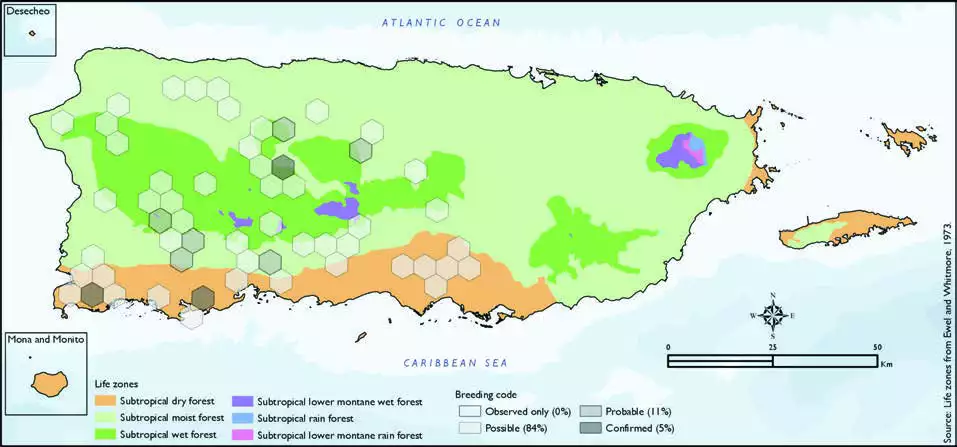Lesser Antillean Pewee
Description
The Lesser Antillean pewee (Contopus latirostris) is a species of bird in the family Tyrannidae.
Distribution & Habitat
The Lesser Antillean Pewee occurs in Puerto Rico (Oberle
2018) and in the northern
Lesser Antilles such as St.
Lucia, Martinique, Dominica,
and Guadeloupe (Raffaele and
others 1998). In Puerto Rico, it
occurs almost exclusively in the
western two-thirds of the island
(Raffaele and others 1998), and
it can be seen regularly at the
Boquerón Nature Reserve and
the Maricao State Forest (Oberle
2018). This species generally
inhabits montane forests, coffee
plantations, coastal scrub forests
(Oberle 2018), and mangroves
(Raffaele and others 1998). The atlas fieldwork yielded a total of
99 records within 56 hexagons
or 12 percent of the 479 total
hexagons (see map). Of the 56
hexagons where this species
was found, breeding met the
atlas definition of confirmed in
5 percent (3) of the hexagons,
probable in 11 percent (6),
and possible in 84 percent (47)
(see map). Lesser Antillean Pewee distribution. The map shows the highest breeding code by hexagon and overlaying the ecological life zones
in Puerto Rico. Note: percentages may not total 100 due to rounding.

Breeding Habits
The Lesser Antillean Pewees nest consists of a cup-shaped
structure made of moss, lichens,
small roots, pieces of thin tree
bark, and other fine materials,
and is usually placed on a 213Lesser Antillean Pewee/Bobitotree limb (Biaggi 1997, Oberle 2018). Previously published
reports indicate that breeding
occurs in the spring (Biaggi
1997). Atlas results show that
this species breeding season
extends throughout the year with
the most breeding activity from
March to June (see chart). The
breeding peaks in May, and in
this month mostly occurs in the
subtropical dry and wet forest
life zones (see chart). Overall,
atlas results (see table and map)
show that the pewee breeds
mostly within the subtropical moist forest life zone (39 percent
of the hexagons) but also in
subtropical wet forest life zones
at higher elevations (30 percent
of the hexagons) and in the
subtropical dry forest life zone
(30 percent of the hexagons).
Conservation
The global population trend of the Lesser Antillean Pewee has
not been quantified or assessed,
but the species is described as
uncommon (Stotz and others
1996). It is suspected to be in
decline in the Lesser Antilles, mostly due to habitat loss (del
Hoyo and others 2004). This
species is currently listed as a
species of least concern by the
IUCN (BirdLife International
2017). Locally, this species is not
listed in any of the threatened
categories of PRDNER and
USFWS. In Puerto Rico, the
Lesser Antillean Pewee has a
protected habitat in land of
about 22 percent or 295 km2 of the total area covered by
the hexagons where evidence
of breeding was found for this
species (1342 km2).
Related Species
Family:
flycatcher